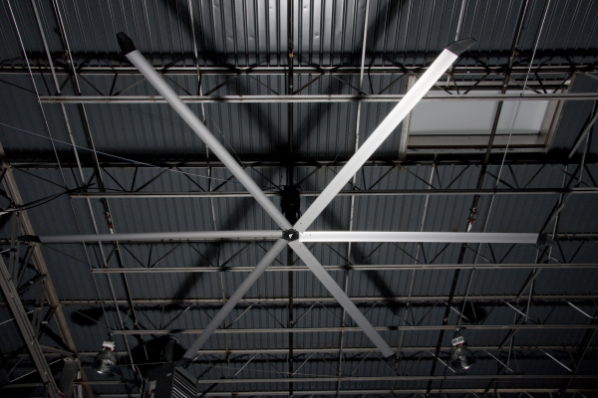Why is Ceiling Fan Clearance Height So Important?
Proper installation of your HVLS ceiling fan is essential. It ensures your fan is running at peak performance to help keep you cooler, healthier, and safer. A big part of the installation process is determining the appropriate ceiling fan height clearance (i.e. the distance from the fan to the ceiling, floor, and wall).
Additionally, the ceiling fan height clearance will slightly differ between each building due to each property’s installation, building codes, fire safety, and national standards.
In this blog, we’ll break down what you need to know about ceiling fan clearances to ensure you’re getting the most out of your ceiling fan.
Ceiling Fan Clearance Height Standards
According to the DOE (Energy Star), “ceiling fans should be installed or mounted, in the middle of the room and at least 7 feet above the floor and 18 inches from the walls. If ceiling height allows, install the fan 8-9 feet above the floor for optimal airflow.” Additionally, most large industrial ceiling fans (HVLS fans) require a 38-96-inch clearance from the ceiling. Guy wires are typically needed at installation to allow this clearance with HVLS fans.

HVLS ceiling fans that range from 6-24 feet in diameter have a higher clearance requirement. MacroAir fans have a minimum height requirement of at least 10 feet above the floor. Most fans have a 3-foot drop standard, meaning your ceiling height must be at least 13 feet. Many models can be shortened to a 2 feet drop standard. MacroAir’s AVD370 can go as short as a 1-foot drop standard.
For safety reasons, ensure ceiling fan blade tips are positioned at least 3 feet away from any area where a person can extend out toward them.
Can Ceiling Fans be too high or low?
.jpg?width=541&name=AirLite_Wide%20(2).jpg)
Yes, ceiling fans can be mounted too high or too low.
The proximity of the fan to the ceiling is an important factor to consider when trying to properly and effectively distribute air. If you mount a ceiling fan without a drop rod, that is called a “ceiling hugger.”
The problem with this type of installation is that the air can't flow from the top of your ceiling into the fan’s blades. However, if you install a drop rod for the fan, you allow the air to flow from the top and throughout the fan, allowing for more efficient air movement.
Positioning your HVLS fan high off the ground has advantages. For instance, if your HVLS fan is mounted at 20 feet, you could reach people as far as 70 feet away. However, the closer the ceiling fan is to the ground, the air’s span is reduced. A good example is when you have a fan inside a cone. As you raise the fan, the air within the cone spreads out; if you lower the fan, the air within the cone shrinks.
How far from the wall can your ceiling fan be?
Your fan should be 1.5 times the fan’s diameter from the wall. For example, if a fan is 6 feet in diameter, multiply 6 x 1.5 = 9. This means the ceiling fan should be 9 feet from the wall.
When determining how many fans you need in your facility, consider the layout of your facility, since large spaces will require multiple fans. You also must think about the spacing between those fans. Depending on the diameter of your fan, you will take that diameter and multiply it by 3 to find the distance between fans. For example, if the diameter of my fan was 6 feet, I would take 6 x 3 = 18. That means there should be 18 feet in between my fans.
Factors to Consider When Buying A Large Ceiling Fan

When shopping for a large ceiling fan, two key components will help you determine the appropriate size of a ceiling-mounted fan for your space:
- Size of the room
- Height of the ceiling
If you have a 16-foot ceiling, the fan will drop to 13 feet automatically because of clearance. For a smaller fan, this is fine. However, a larger fan will need as much as a 5-foot drop, considering the fan will be brought down to 11 feet.
According to fan expert, Jason Hornsby, “when you… have a lower ceiling height, a short blade HVLS fan would work better. The reason is that small fans have a higher RPM (Revolutions per Minute) which increases velocity.”
A larger fan will revolve at a much slower speed. It has a larger volume, but a lower speed. This is important to note because if you select a blade size that is too large for your space, the fan might underperform compared to a smaller fan.
Sprinkler and Safety Standards

The National Fire Protection Agency (NFPA) lays out the standards for how HVLS fans should be installed in buildings with sprinklers (in its NFPA 13 document). The NFPA 13 indicates that the vertical clearance from the HVLS fan to sprinkler deflectors must be a minimum of 3 feet.
In addition to NFPA 13 guidelines, HVLS ceiling fans should have proper safety components included with each installation. MacroAir includes guy wires to ensure the fan is safe and secure no matter the application.
For more information on installing large ceiling fans in buildings with sprinklers, you can read all the requirements in the list of NFPA codes and standards. Additionally, you can read one of our recent MacroAir blogs that outlines key guidelines for placing HVLS fans in sprinkler-protected buildings.
Residential Ceiling Fan Clearance

Ceiling fan clearance is crucial for residential fans because it directly impacts the fan's performance, safety, and overall comfort. Here are some key reasons why it matters:
- Optimal Airflow: Proper ceiling clearance ensures fans can circulate air effectively. If a fan is too close to the ceiling, it won't move air as efficiently, reducing its ability to cool or circulate warm air.
- Safety: Adequate distance between the ceiling and the floor prevents accidental contact with the blades, especially in rooms with lower ceilings or areas where people might walk under the fan.
- Energy Efficiency: When a fan has enough clearance, it can operate at its intended efficiency. This helps maintain a comfortable room temperature without overworking your HVAC system, which can save on energy costs.
- Noise Reduction: A fan with insufficient clearance may create more noise due to restricted airflow, blade vibrations, or interference with the ceiling.
- Aesthetic Balance: Proper clearance ensures the fan looks well-proportioned in the room, contributing to the overall design and feel of the space.
Most residential ceiling fans need at least 8-9 feet of clearance from the floor to the fan blades for optimal performance and safety.
Lincoln Street Residential Fan by MacroAir

The Lincoln Street fan by MacroAir is available in 62-inch, 72-inch, and 84-inch diameters. This residential ceiling fan offers a modern ceiling fan design that complements various spaces.
It features six durable nylon blades and a powerful, energy-efficient direct drive motor, delivering smooth air circulation. The fan has a reverse function for year-round comfort, smart-home integration through Bond Bridge©, and remote controls for quick adjustments.
With its sleek, modern style, the Lincoln Street fan will not only provide powerful airflow but enhance the aesthetic of any indoor or outdoor space.
For more options, check out MacroAir’s selection of ceiling fans for indoor and outdoor spaces.
Let MacroAir Help You Get Started

The above information is a great place to start. However, ceiling height requirements differ slightly between the DOE, NFPA, and each unique building.
Therefore, the best option is to contact ceiling fan experts from the fan company to help you determine your ceiling fan clearance. MacroAir's experts are always available to answer any questions you may have about ceiling fan clearance and spacing requirements for your fan. They can also help you pick the right fan for your space and ensure it is properly installed and running at optimal levels to help keep your space cool, healthy, and safe.
Whether you are installing a fan in a residential living space or a large commercial facility, contact MacroAir for professional guidance to ensure your ceiling fan is perfectly installed and optimized!


